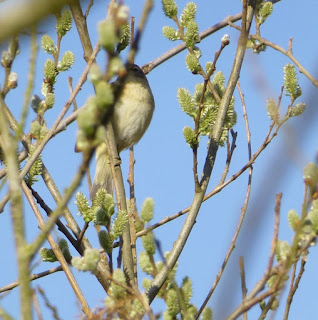Early mass flowering is a lifesaver for bumblebees, hoverflies and other pollinators, when there is little else out in bloom. Garden plants can contribute, but willow is where the bees will be. So, off to
The Old Sludge Beds DWT nature reserve on the southern outskirts of Exeter to see what might be out and about.
 |
| More-than-you-can-eat buffet for bees |
Willow is dioecious, that is, there are separate male and female plants. High throughout the canopy, the male catkins were attracting a profusion of queen bumblebees,
Bombus terrestris and the odd
Bombus hypnorum, presumably for protein-rich pollen over a nectar energy drink, alongside numerous flies.
Eristalis pertinax is one of the first hoverflies on the wing.
 |
| Male catkin with Eristalis pertinax hoverfly (front pairs of lower legs yellow) |
 |
| Willow female flowers |
I wasn't the only one to notice. Chiffchaffs were flitting through the floral haze, picking off insect prey items faster than a camera auto-focus.
 |
| Chiffchaffs taking advantage of the all-you-can-catch insect buffet |
An occasional sparrowhawk circled overhead, completing the food chain.





No comments:
Post a Comment